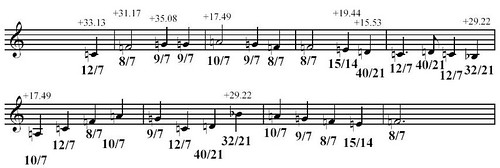
Example 1: Hymn Melody
Just Transposition
Here is the 5-limit tuning worked out in a previous post:

Example 2: Hymn Melody in 5-limit Just Intonation
Transposition involves moving each pitch in a melodic line by a fixed interval. In just transposition we simply use a fixed just interval. To calculate the correct frequency ratio one only needs to multiply by the fixed interval ratio. For example, if we were to transpose this 5-limit hymn melody up by an 8/7 major second we would have the following:

Example 3: Hymn Melody transposed by 8/7.
Now this 5-limit melodic line is shifted into a 7-limit space, even though the melodic line itself adheres to a 5-limit sound. It is only 7-limit relative to the E Flat 1/1 pitch.
Retrograde Melody
Another relatively straight forward function for melodic transformation is retrograde melody. For example, this hymn melody played in reverse would look like this:

Example 4: Hymn Melody - Retrograde.
A couple of variations on the retrograde function to consider involve separating the pitch sequence and rhythm and reversing them independently.

Example 5: Hymn Melody - Pitch order Retrograde.

Example 6: Hymn Melody - Rhythmic Retrograde.
These are relatively simple operations that could be combined with transposition functions (or any other functions) to form counterpoint lines with the original melodic line for a unified polyphonic texture or used sequentially for melodic variation. Next time we return to this melody we'll take a look at some possible inversion strategies.


No comments:
Post a Comment